-

人教版新目标初中英语八年级上册How was your school trip教案2篇
“Go for it!” is based on “Task-Based Language Teaching”. It adheres to “The authenticity principle”, “The form-function principle”, “The task dependency principle” and “The principle of learning by doing”. These principles all accord with the demands of curriculum focus.In and of Grade Seven (II), “Go for it!”, students have learned “The Simple Past Tense”. And it appears again in of Grade Eight (I). teaches students more about how to talk about events in the past. In addition, it gives affirmative and negative statements in the past tense, such as the sentence patterns “Did you see …?” “Were there …?” “Did you go …?” As the first part of Unit 8, Section A opens with a picture presenting the last school trip in the aquarium and continues with several step-by-step practice activities, which are all good for students to master “The Simple Past Tense”. Doing well in Section A will help students integrate the new target language with that in Section B. Thus, they can describe the events in the past freely and foster their own ability of reflecting and practicing. II. Teaching ObjectivesTeaching objective is the beginning and aim of teaching activities. According to the overall goal of the English elementary course--- improve students' synthetic ability of language application, which should be based on the development of students’ “Language knowledge”, “Language skills”, “Character building”, “Learning strategies” and “Cross-cultural awareness”. The teaching objectives are described as follows(I). Knowledge objectivesi. Master the simple past tense of regular and irregular verbsii. Recite the new words and expressions about the last school trip in the aquarium, including their pronunciation and intonation

人教版新目标初中英语八年级上册Could you please clean your room教案3篇
一、 教学内容Section A 1a----1c二、 教学目标1.学习词汇do the dishes, make the bed, take out the trash, fold the clothes, do the laundry, sweep the floor, clean the living room.2.句型 Could you please clean your room? Yes, sure.三、 教学准备 学生预习本单元所有的词汇多媒体课件 活动表 奖品四、 教学过程Pre-task1. Warming upEnjoy ourselves. Watch cartoon Cinderella. 看动画片段《灰姑娘》导如入本课话题和新词汇“chores”美丽善良的鬼姑娘因继母的嫉妒,每天得做所有的家务。片段的主题使学生联想到本课的话题。2. learn new words and phrasesLook! What is she / he dong? 看图学习动词词组do chores, do the dishes, make the bed, take out the trash, fold the clothes, do the laundry, clean the living room.3. Guessing game.What is she doing ? 4. Pair work. 1a, Do you do these things at home? Write “Y” for “yes” and “N” for “no”.5. Listening . 1b , Peter’s chores or Mom’s chores?理解目标语Could you please clean your room? Yes, sure.Write “M” for Mom’s chores, “P” for Peter’s chores in the chart.6. PairworkLook at the picture,Ask your partner to do the chores that you see. 7. Interview Who is the most able at home? 1) What chores do you do at home? How often do you do the chores? Work in four, interview each of the students in the group, fill in the chart.

人教版新目标初中英语八年级上册How do you get to school教案2篇
Step Ⅶ Role play ( Work on 1b)1. First ask two students to read the dialogue to the class.Sa: How do you get to school?Sb: Well, I ride my bike to the subway station. Then I take the subway.2. Now work with a partner.Suppose you use two kinds of transportation to get to school \Hangzhou\Beijing... (bus, train, subway, walking, bike, etc.) Tell how you get there. You may use the phrases in 1a.3. Then ask different pairs of students to present their conversations to the class.Step ⅧListening1. Work on 2a(1) First ask students to read the list of information that Thomas wants to know.…where Nina lives.…how far from school she lives.…how long it takes to get to school.…how she gets to school.…what she thinks of the transportation.(2) Tell students what transportation and bus stop mean.bus stop 汽车站 transportation n. 运送;运输Then tell students we'll hear a recording. Please put a checkmark in front of each thing that Thomas wants to know.(3) Now play the recording for students.( Have students pay attention to the sample answer.) (4) Then correct the answers.

人教版新目标初中英语八年级上册I’m more outgoing than my sister教案2篇
1 交通工具的比较此活动为小组活动。学生通过讨论找出到达某一城市可乘坐的各种交通工具,并选择最佳出行方式。Teacher:We’re going to Shanghai. How many ways can we use to get there? Yes, there are four ways: by bus, by plane, by train, by ship. Please discuss how you are going to get there.操作建议:(1)学生以小组为单位展开活动,谈论本组所选择的交通工具。(2)各组选代表向全班汇报,阐述本组所选择的交通工具的利和弊。完成任务所需要的语言结构:We can go there by ship. It’s more comfortable and cheaper than any other transportation.We can go there by bus. It’s cheaper but it takes longer time.2 哪个城市更合适?此活动具有挑战性。假设中国要举行2014年世界杯足球赛,分别从历史,人文,天气等方面对各城市(北京,大连,上海,昆明)进行比较,选择最佳举办城市。T: Imagine China is holding the 2014 FIFA World Cup. Which city do you think is the best for the World Cup, Beijing, Dalian, Shanghai or Kunming? Let’s work in groups. If you choose Beijing, please join the Team Red. If you chose Dalian, please join the Team White. If you choose Shanghai, please join the Team Blue. If you choose Kunming, please join the Team Green. Please show us its advantages. Then let’s see which team will win.

人教版新目标初中英语八年级上册What’s the best radio station教案2篇
教学重点和难点:运用所掌握的语言描述,比较不同地点的特点。在练习中学习掌握英语比较级和最高级的用法。课前准备分配小组,每组五至六人。通过上网或翻阅报刊杂志等方法,确定旅游线路,做出基本的旅游计划。教学设计:本节课流程图 学法指导:1.由于这是一堂新课,在教学中应注意面向全体,发挥学生的主体性,引导学生积极参与,激发学生的求知欲和学习积极性,指导学生积极思维,主动获取知识,养成良好的学习方法。逐步学会独立解决问题。总之要尽可能调动学生的非智力因素促进智力因素的发展。教法选择:1.电化教学法2.课堂讨论法3.任务型教学法采用这些方法的目的是为了充分调动学生的学习积极性,使学生变被动学习为主动学习。通过电脑形象的演示,加强印象,提高兴趣,突破难点,提高教学效率,进而增大教学的容量和信息量。充分体现教师为主导,学生为主体的教学原则。

人教版新目标初中英语八年级上册What’s the matter教案2篇
She shouldn’t go to the party tonight.Step7. TaskT: You know, there are lots of problems in our life. If you are a doctor, please tell us how to solve the problem. I will divide you into 9 groups. Please work in groups. And then choose one of you to report your ideas.The following are the problems:I have a toothache.I am hungry. I have a sore throat.I am stressed out. I have a sore back.I am tired. I can’t sleep.I have a cold. I have a headache.Report: If you have a headache, you should go to bed early. You should see the doctor. You should eat some medicine. You shouldn’t wash your face with cold water.You shouldn’t sleep late.You shouldn’t swim.…..T encourages the students to give advice as much as possible.Homework:1. Chose one of the problems, and write down your advice2. Copy the new words这一步是用于热身的,同时也可以让他们复习一部分的表示人体部位的单词,扩充知识.学习语言的过程也是一个不断积累的过程,复习旧知识,增添新知识.通过小游戏,强化学生对Does she/he have…这个句子的运用能力.通过复习,自然的引到下面新知识的学习。充分利用表格,由句子到对话,再到文章,让学生循序渐进. 提高学生的综合语言运用能力,运用以前学过的知识来解决身边的问题.Period 5 (Section B 3a—3c, selfcheck)教学内容与分析:

人教版新目标初中英语九年级上册Teenagers should be allowed to choose their own clothes教案2篇
Step 1 Greeting Greet the class and check the homeworkStep 2 A duty report The S on duty gives a report on the rules in his home and lead in 3a “Sun Fei’s and Wu Yu’s rules” Step 3 ReadingSs read the conversation and write the two girls’ rules in the chart. Check the answers.Get Ss to read after the tape and then read aloud by themselves. Then, T explains the language points.Step 4 Pairwork 3bRole play. Use the information in chart to practice with the conversation in 3a covered. They can look at the sample conversation in the right box.Step 5 Task 2 “Who’s the best reporter?”Make a survey by asking any 5 students the questions in the chart in activity 4. Then give out a report about it. See who is the best reporter? And the best reporter will get a nice ball-pen.Step 6 Summary and homework:Write out the report in your exercise-books.Period ThreeStep 1 Greeting and a duty reportThe S gives a duty report talking about his experience of being late for school. Lead in the question “Do you ever get to school late? How often do you get to school late? Always, usually, sometimes, or never?Step 2 1a Get Ss to finish writing.Step 3 Pairwork 1b Get Ss to talk about their answers with their partners using the sample conversation in the box on the right.Step 4 Listening practice2a Lead-in: What will happen if you get to school late? What about Peter? Let’s listen to a conversation between Peter and his father. Get Ss to finish 2a (As usual, for the first time, Ss only listen.) Check the answers.

人教版新目标初中英语九年级上册I like music that I can dance to教案
教学目标: 1. Express preferences2. Talk about one’s likes and dislikes and the reasons3. Learn to express one’s opinions 4. Learn to write a reply 语言功能: 1) Talk about one’s preferences, using t he relative clause2) Talk about people’s likes and dislikes and the reasons3) Talk about opinions语言结构: Relative clauses with that and who语言目标:What kind of music do you like?I like music that I can sing along with.I love singers who write their own music.We prefer music that has great lyric.重点词汇及短语:heart, photography, interest, class, whatever, miss, okay, expect, sweet, taste, itself, laboratory, cancer, increase, biscuit, main, care, prefer… to…, remind somebody of …, dance to, sing along with, be sure to, interest somebody, make somebody adj., to be honest, suit somebody, on display, catch up教学重难点:What do other people think of the different kinds of things? How to express one’s opinions? 学习方式:讨论,合作学习情感目标:通过本单元的学习,能提高学生的艺术鉴赏能力和审美情趣,并引导学生养成健康的饮食习惯。课时安排5课时第一课时:Section A: 1a-2c第二课时:Section A : 3a-4第三课时:Section B:1-2c, Self check2第四课时:Section B: 3a-4, Self check1第五课时:Self check ReadingI like music that I can dance to.

人教版新目标初中英语九年级上册I used to be afraid of the dark教案
内容提示1.本单元主要内容是学会used to结构。Used to +动词原形表示过去经常、以前常常,只用于过去式中,用来表示现在已不存在的习惯或状态。例如:They used to play football together.他们过去常在一起蹋足球。(现在不在一起踢了)2.used to的疑问形式和否定形式为Did you use to…?和I didn’t use to… 也可以用Used you to…?和I used not to…但现在多使用前者。例如:Did you used to swim in the river? 你过去常在河里游泳吗?I didn’t use to play the piano. 我以前并不经常弹钢琴。教学目标一、学习目标(Language Goal) 1.学会陈述自己过去常做的事情。2.学会陈述自己过去的爱好等。3.能够表达自己现在和过去在外表、性格、娱乐等方面的变化。4.能够表达朋友、家人等现在和过去的变化。二、语言结构(Language Structures) 1.I used to be short when I was young. 我年轻时个子很矮。 2. —Did you use to have straight hair? 你过去是直发吗?—Yes, I did. 是的。 3. —Did you use to play the piano? 你过去弹钢琴吗?—No, I didn’t. 不,我不弹。 4.I used to be afraid of dark. 我过去害怕黑暗。 5.I’m terrified of the snakes. 我害怕蛇。

人教版新目标初中英语九年级上册How do you study for a test教案2篇
内容提示本单元主要内容是学会利用verb十by/with gerund表示方式方法来讨论学习英语的策略,认识自己在学习方面的长处和不足。初步了解现在完成时的结构和用法。现在完成时由助动词have/has+动词的过去分词构成,主要表示过去发生的某一动作对现在仍有影响或造成的后果,常与already,yet,just,ever,never等副词连用。教学目标一、学习目标(Language Goal) 1. Talk about how to study . 学会讨论各种学习方法和策略。2. Find out your suitable learning methods. 找出适合自己的学习方法。 二、语言结构(Language Structures) 1. Verb + by with gerund by+动名词短语 表示“通过…途径,方法” 2. How questions have引导的特殊疑问句 三、目标语言(Target Language) 1. How do you study for tests ? 你是怎样准备考试的?Well , I study by working with my classmates. 哦,我和同学们一起学习。2. Have you ever studied with a group ? 你曾经参加过学习小组吗?Yes , I have . I’ve learned a lot that way . 是的,参加过。通过这种方式我学了许多。
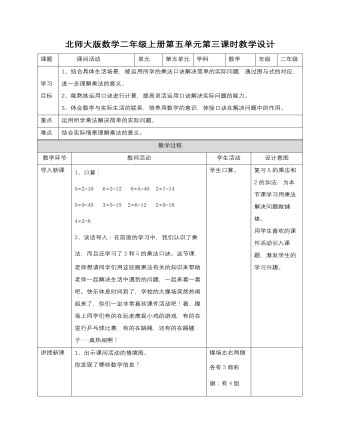
小学数学北师大版二年级上册《第三课课间活动》教案
1、结合具体生活场景,能运用所学的乘法口诀解决简单的实际问题,通过图与式的对应,进一步理解乘法的意义。 2、能熟练运用口诀进行计算,提高灵活运用口诀解决实际问题的能力。 3、体会数学与实际生活的联系,培养用数学的意识,体验口诀在解决问题中的作用。 运用所学乘法解决简单的实际问题。 结合实际情景理解乘法的意义。 1、口算: 5×2=10 6×2=12 8×5=40 2×7=14 5×9=45 3×5=15 2×6=12 2×9=18 4×2=8 2、谈话导入:在前面的学习中,我们认识了乘法,而且还学习了2和5的乘法口诀。这节课,老师想请同学们用这些跟乘法有关的知识来帮助老师一起解决生活中遇到的问题,一起来看一看吧。快乐休息时间到了,学校的大操场突然热闹起来了,你们一定非常喜欢课件活动吧!看,操场上同学们有的在玩老鹰捉小鸡的游戏,有的在进行乒乓球比赛,有的在跳绳,还有的在踢毽子……真热闹啊!

人教版高中政治必修1社会主义市场经济教案
教师总结:社会主义市场经济是使市场在国家宏观调控下起基础性配置作用的经济,充分发挥市场基础性调节作用,就必须主要靠经济手段、法律手段,而不是行政手段。(三)课堂总结、点评这节课我们重点学习了社会主义市场经济的有关知识,知道了社会主义市场经济的基本特征,以及国家宏观调控的含义、目标和主要手段。这对于我们在经济生活中正确地认识我国市场经济的性质和作用,理解国家宏观调控的措施及意义,增强社会主义优越感和民族自强意识,自觉投身现代化建设等将有重大指导作用。★课余作业 讨论:联系经济生活中国家宏观调控的实例,讨论应如何认识和理解国家各种宏观调控手段的综合运用,对国民经济发展的意义。★教学体会 本节内容与学生生活实际联系密切,在学习中应该多引入日常生产、生活中常见的一些宏观调控实例,让学生去深刻理解、把握宏观调控手段及其作用。
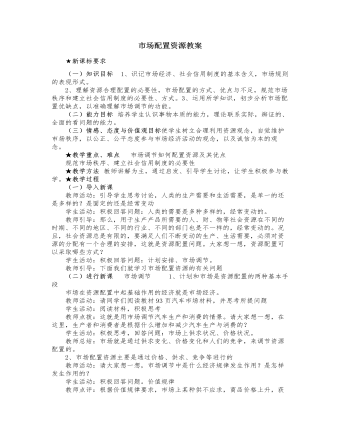
人教版高中政治必修1市场配置资源教案
教师点拨:这则材料说明,市场调节有其局限性,单纯的市场调节具有自发性、盲目性、滞后性等缺点。市场调节不是万能的。社会生活中有很多领域和产品不能用市场来调节,如国防、治安、消防等产品的供给问题,枪支弹药、麻醉品等都不能让市场来调节。市场调节具有自发性、盲目性、滞后性。自发性:由于市场调节是在价值规律自发作用下进行的,在利益驱动下会产生一些违反市场原则的行为,如制造、销售假冒伪劣商品,大量排放废水、废气破坏环境,窃取他人智力成果等等。盲目性:由于人们不可能完全掌握生产各方面信息及其变化趋势,致使决策带有一定的盲目性。如某种商品有利可图则一哄而上,反之则一哄而退,从而造成资源浪费和消费得不到充分满足。滞后性:由于市场价格的形成和传递有一个过程,一旦传递到生产经营者手中进行生产调整,就有一个时间差,致使市场调节带有滞后性,成为一种事后调节。
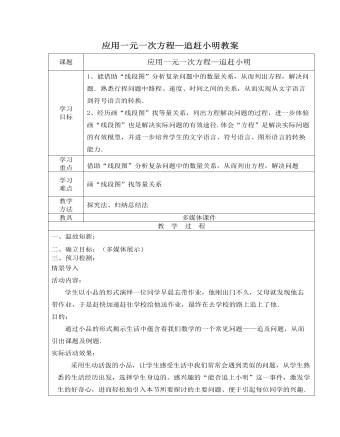
北师大初中七年级数学上册应用一元一次方程——追赶小明教案2
由于题目较简单,所以学生分析解答时很有信心,且正确率也比较高,同时也进一步体会到了借助“线段图”分析行程问题的优越性.六、归纳总结:活动内容:学生归纳总结本节课所学知识:1.会借线段图分析行程问题.2.各种行程问题中的规律及等量关系.同向追及问题:①同时不同地——甲路程+路程差=乙路程; 甲时间=乙时间.②同地不同时——甲时间+时间差=乙时间; 甲路程=乙路程.相向的相遇问题:甲路程+乙路程=总路程; 甲时间=乙时间.目的:强调本课的重点内容是要学会借线段图来分析行程问题,并能掌握各种行程问题中的规律及等量关系.引导学生自己对所学知识和思想方法进行归纳和总结,从而形成自己对数学知识的理解和解决问题的方法策略.

北师大初中七年级数学上册利用去分母解一元一次方程教案1
探究点三:列一元一次方程解应用题某单位计划“五一”期间组织职工到东湖旅游,如果单独租用40座的客车若干辆则刚好坐满;如果租用50座的客车则可以少租一辆,并且有40个剩余座位.(1)该单位参加旅游的职工有多少人?(2)如同时租用这两种客车若干辆,问有无可能使每辆车刚好坐满?如有可能,两种车各租多少辆?(此问可只写结果,不写分析过程)解析:(1)先设该单位参加旅游的职工有x人,利用人数不变,车的辆数相差1,可列出一元一次方程求解;(2)可根据租用两种汽车时,利用假设一种车的数量,进而得出另一种车的数量求出即可.解:(1)设该单位参加旅游的职工有x人,由题意得方程x40-x+4050=1,解得x=360,答:该单位参加旅游的职工有360人;(2)有可能,因为租用4辆40座的客车、4辆50座的客车刚好可以坐360人,正好坐满.方法总结:解题关键是要读懂题目的意思,根据题目给出的条件,找出合适的等量关系,列出方程再求解.
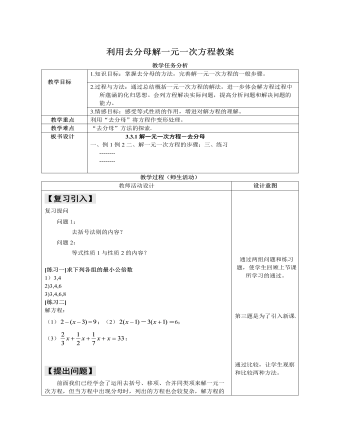
北师大初中七年级数学上册利用去分母解一元一次方程教案2
先让学生自己总结,然后互相交流,得出结论。解一元一次方程,一般要通过去分母,去括号,移项,合并同类项,未知数的系数化为1等步骤,把一个一元一次方程“转化”成x=a的形式。解题时,要灵活运用这些步骤。板书:解一元一次方程一般步骤:1、 去分母-----等式性质22、 去括号----去括号法则3、 移项----等式性质14、 合并同类项----合并同类项法则5、 系数化为1.----等式性质2【课堂练习】练习:解下列一元一次方程解方程: (2) ;思路点拔:(1)去分母所选的乘数应是所有分母的最小公倍数,不应遗漏。(2)用分母的最小公倍数去乘方程的两边时,不要漏掉等号两边不含分母的项。(3)去掉分母后,分数线也同时去掉,分子上的多项式用括号括起来。回顾解以上方程的全过程,表示了一元一次方程解法的一般步骤,通过去分母—去括号—移项—合并同类项—系数化为1等步骤,就可以使一元一次方程逐步向着 =a的形式转化。

北师大初中七年级数学上册利用去括号解一元一次方程教案2
小明说:“我姐姐今年的年龄是我去年的年龄的2倍少6,”已知姐姐今年20岁,问小明今年几岁?若取小明今年为x岁,则依据下面的等量关系式列方程:姐姐今年的年龄=小明去年年龄的2倍-6.得2(x-1)-6=20.例5解方程-3(x+1)=9总结:根据乘法分配律和去括号法则(括号前面是“+”号,把“+”号和括号去掉,括号内各项都不改变符号;括号前面是“-”号,把“-”号和括号去掉,括号内各项都改变符号)去括号时要注意:1、 不要漏乘括号内的任何一项;2、若括号前面是“-”号,记住去括号后括号内各项都变号.习题训练:解方程,如课本P122练一练1,P113练一练2等.思维拓展,解简单的应用题,如课本P123练一练3或补充一些题,如含小括号、中括号、大括号的方程(这方面课本安排几乎没有,只限浅显问题,教师不必深究)
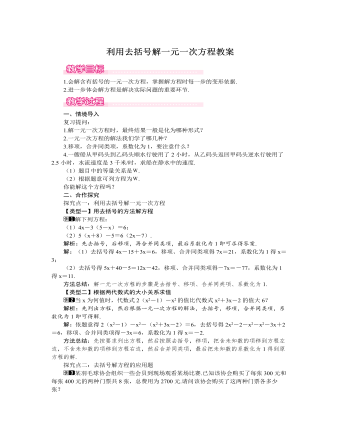
北师大初中七年级数学上册利用去括号解一元一次方程教案1
解:设每张300元的门票买了x张,则每张400元的门票买了(8-x)张,由题意得300x+400×(8-x)=2700,解得x=5,∴买400元每张的门票张数为8-5=3(张).答:每张300元的门票买了5张,每张400元的门票买了3张.方法总结:解题的关键是熟练掌握列方程解应用题的一般步骤:①根据题意找出等量关系;②列出方程;③解方程;④作答.三、板书设计本节课的教学先让学生回顾上一节所学的知识,复习巩固方程的解法,让学生进一步明白解方程的步骤是逐渐发展的,后面的步骤是在前面步骤的基础上发展而成的.然后通过一个实际问题,列出一个有括号的方程,大胆放手让学生去探索、猜想各种解法,去尝试各种解题的途径,启发学生在化归思想影响下想到要去括号.
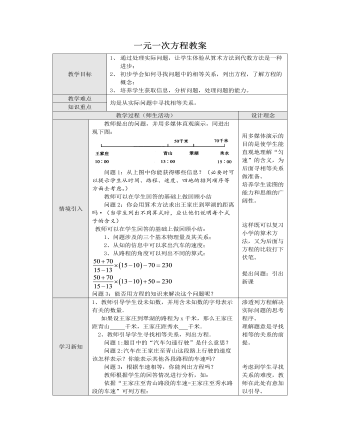
北师大初中七年级数学上册一元一次方程教案2
1、突出问题的应用意识.教师首先用一个学生感兴趣的实际问题引人课题,然后运用算术的方法给出解答。在各环节的安排上都设计成一个个的问题,使学生能围绕问题展开思考、讨论,进行学习.2、体现学生的主体意识.本设计中,教师始终把学生放在主体的地位:让学生通过对列算式与列方程的比较,分别归纳出它们的特点,从而感受到从算术方法到代数方法是数学的进步;让学生通过合作与交流,得出问题的不同解答方法;让学生对一节课的学习内容、方法、注意点等进行归纳.3、体现学生思维的层次性.教师首先引导学生尝试用算术方法解决间题,然后再逐步引导学生列出含未知数的式子,寻找相等关系列出方程.在寻找相等关系、设未知数及作业的布置等环节中,教师都注意了学生思维的层次性.4、渗透建模的思想.把实际间题中的数量关系用方程形式表示出来,就是建立一种数学模型,教师有意识地按设未知数、列方程等步骤组织学生学习,就是培养学生由实际问题抽象出方程模型的能力.
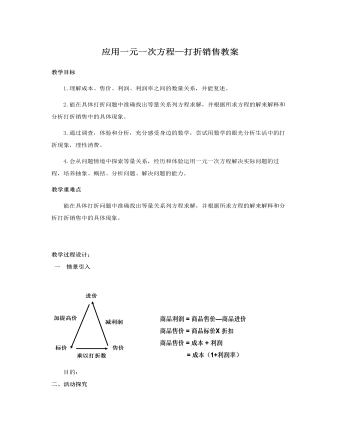
北师大初中七年级数学上册应用一元一次方程——打折销售教案2
两道例题,第一道题师生共同分析,第二道题学生自己分析。部分学生在运用方程解答问题时,等量关系的寻找还是有困难,规范解题不够合理,仍需在作业过程中教师给予适当的指导。四、课堂小结这节课我们学习了有关打折销售的知识,其实类似的问题我们小学也遇到过,今天在分析实际问题时又用到了列表法,通过这节课的学习,谈谈你在知识方面的收获。提示学生通过对《日历中的方程》《我变高了》以及本节《打折销售》学习还有以往经验,让学生分组讨论,用一元一次方程解决实际问题的一般步骤是什么?目的:让学生进一步体会方程的作用,这里教师又提到学生的小学学习,目的是想提示学生,将今天的方程解法与小学学过的算术方法相对比。此活动的目的是使学生不再处于被动状态,而成为积极的发现者。